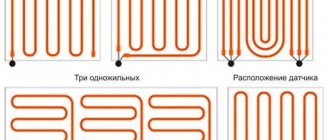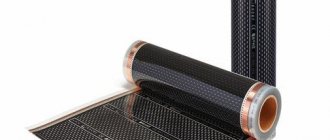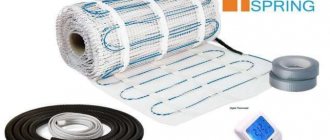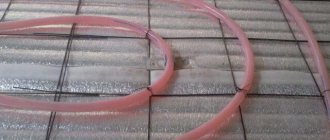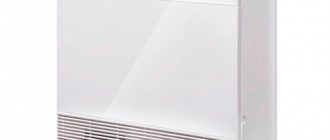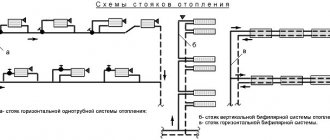One of the most important factors in creating a comfortable environment in a room is considered to be floor insulation with heat-insulating materials. The relevance of this parameter increases under the condition that groundwater runs close to the surface, in the areas of access to outside air, as well as on the border of unheated and heated premises.
Correctly carried out thermal insulation of the floor will allow you to set the proper temperature level in the room and reduce heating costs.
Materials used as heaters must have certain characteristics, including durability, moisture resistance, compressive strength and thermal conductivity. The technology of insulation differs depending on the type of material, the most common are expanded polystyrene, expanded plastic, expanded clay, foam, foam under the screed.
Floor insulation with expanded polystyrene
Expanded polystyrene is a gas-filled material obtained from copolymers of styrene and polystyrene. Gas-filled styrene granules are dissolved in a polymer mass, during the heating of which the volume of the original granules increases many times.
Expanded polystyrene is obtained by sintering granules.
Benefits:
- ease of use - polystyrene foam plates are easily cut with a knife or hacksaw, the material is attached with glue, cement mortar or mounting devices;
- a light weight;
- environmental Safety;
- resistance to chemical and biological influences;
- low cost;
- durability (over 50 years);
- moisture resistance;
- insulation.
Disadvantages:
- thermal deformation, at a temperature of + 80-90 degrees;
- flammability, gas-filled granules can ignite at high temperatures;
- instability to physical damage.
Floor insulation technology on logs
Wooden floor elements are treated with moisture-proof agents and antifungal agents, from the lower side of the logs, sheets of chipboard or boards are attached to self-tapping screws. Pre-cut to size sheets of expanded polystyrene are laid on them, a film is laid on top of the covering, after which the floor covering is laid.
Warming with expanded clay
Expanded clay is a porous granules of clay rock. It is these air pores that help trap heat inside the floor. Expanded clay pebbles do not burn in fire, and do not drown in water. Therefore, it is the most refractory and safest material.

Expanded clay is small clay pebbles
As a heater, it is effective only with a layer of 10-15 cm. This means that the floor will have to be raised that much. This is a minus.
But there are more pluses. This material has good thermal insulation properties. For example, 10 cm of expanded clay are comparable in terms of thermal conductivity with brickwork 1 m thick. Expanded clay is also light and durable. Non-toxic and retains its properties for many years.
Expanded clay is very cheap. It is chosen by those who value environmentally friendly and natural materials.
How to lay expanded clay


The screed must be thick so that the expanded clay does not move
How to properly insulate the balcony floor with expanded clay? We describe:
1. Pour expanded clay on the surface of the floor in a layer of 10 cm. Use the largest granules. They will slip less while you pour the solution.
2. Next, make a screed (yes, thicker!) No more than 3 cm thick on top of it. At the same time, the solution should spread evenly and go into the depths, grasping the entire layer of expanded clay.
3. When you start pouring, try not to step on the expanded clay.Use islands made of plywood or any other material to move on the floor.
4. The last stage of warming the floor on the balcony with expanded clay is to iron the coating with a needle roller. Then the floor will be even and neat.
Floor insulation with foam
Polyfoam is considered the most optimal material for floor insulation.
Benefits:
- versatility, the material can be used to insulate wooden and concrete floors, as well as walls, facades, roofs and ceilings;
- ease of installation, laying the foam does not require much effort, no dowels and other elements are needed to fasten it, in some cases the use of glue is allowed;
- thermal insulation properties, in summer it is warm in such a house, and cold in winter;
- environmental safety, the material does not emit toxic and harmful substances into the atmosphere;
- resistance to biological and chemical substances.
Disadvantages:
- fragility;
- cracking under the influence of UV rays;
- fire resistance.
Technology
The process of foam insulation is as simple as possible; it does not require special skills. The density of the foam should be 35 kg / m, the thickness should be 20 mm.
A layer of polystyrene is laid on the concrete cover, free from dust and debris, without gaps.
All crevices and gouges must be pre-filled with filler or construction foam. Foam boards are laid on a polyethylene film in three ways: according to the basic installation, in a diagonal way, in a run-up. In the first case, the sheets are laid in regular rows parallel to the walls, in the second case at an angle of 45 degrees to the walls, in the latter case the angles at the joints of the slabs do not coincide.
With this method of insulation, the foam is covered with a plastic wrap on top, laying a laminate or floor tiles involves laying a PVC membrane on top of which chipboard is placed.
The cement screed is poured onto a waterproofing film, the complete drying of which, depending on the layer thickness, takes 3-4 weeks.
Forced insulation of a finished wooden floor
The cold floor in the room does not leave a pleasant impression and sometimes you have to insulate it.
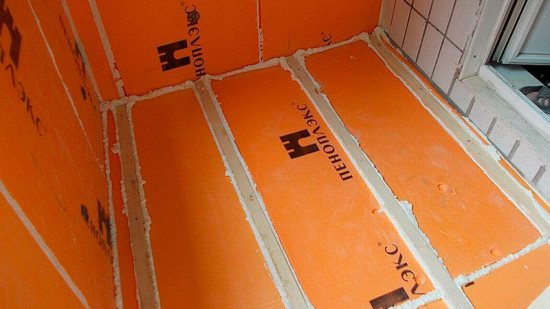

This requires:
- Remove the skirting boards around the room.
- Carefully, without damaging, remove the topcoat boards. Number them in the order of their location, remove the nails.
- Dismantle the subfloor.
- If necessary, add expanded clay just above the lower level of the lag, carefully level it and tamp it.
- Cut the foam plates according to the distance between the logs and along the length of the room.
- Lay the first layer, glue the joints with tape.
- Lay the second layer in the same way, ensuring that the joints overlap. Glue the joints.
- Restore the sub-floor.
- Install the topcoat, setting the boards according to the numbering in the reverse order.
- Nail down the skirting boards.
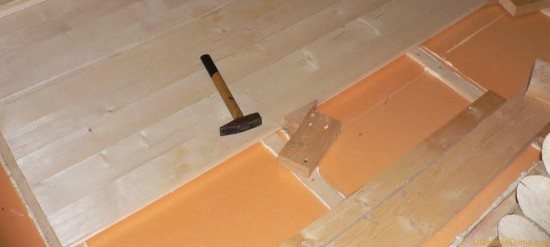

In this case, we recommend using plates with a minimum thickness of 20 mm in two layers. This is enough to successfully resolve the issue.
Helpful article? Bookmark it!
IT MAY BE INTERESTING FROM THE AUTHOR
Floor insulation
Choosing floor coverings for a water heated floor
Floor insulation
Izolon: features, types and common areas of application of the material
Floor insulation
Insulation of the floor with expanded clay
Floor insulation
Installation of underfloor heating - instructions
Floor insulation
Warm floor under tiles - selection, installation
Floor insulation
Electric underfloor heating
Insulation of the floor with expanded clay
Expanded clay is an environmentally friendly insulation, the material is a lightweight porous material obtained by quickly firing low-melting clays. Expanded clay consists of round or oval granules of different sizes.
Benefits:
- ease of installation;
- affordable cost;
- energy efficiency;
- soundproofing;
- resistance to temperature extremes;
- frost resistance;
- water absorption;
- environmental friendliness.
disadvantages
- fragility;
- the thickness of the insulating layer imposes restrictions on the use in rooms with low ceilings.
Technology
Expanded clay can be used to insulate concrete and wood floors.
After cleaning from dirt and dismantling the old floor covering, a layer of waterproofing is laid. The installation of the thermal insulation film is overlapped, the joints are glued with special tape. It should be borne in mind that the film should go behind the wall at a distance of 8-10 cm.
At the next stage, expanded clay is filled up, while shrinkage must be taken into account. The thickness of the thermal insulation layer should not exceed 15 cm; expanded clay of different fractions is used for backfilling. At the final stage, a leveling screed is applied.
In the process of floor insulation, it is necessary to take into account the loads; the energy efficiency and bearing capacity of the floor depend on the thickness of the expanded clay layer. A layer of 15 cm provides an adequate level of thermal insulation, but the floor may not withstand dynamic and static loads.
Expanded clay or Penoplex which is better - Floor insulation: Expanded clay or Penoplex?
The material behaves well when exposed to low temperatures and with a sharp change in performance. An equally important characteristic is biostability. Extruded polystyrene foam does not affect fungi and insects.
Also, the material is highly resistant to fire. In addition, it prevents the spread of flame to other areas of the building. This property of the insulation favorably distinguishes it from other options. Extruded polystyrene foam interacts well with various building materials. This allows it to effectively fight corrosive processes.
It becomes more resistant to mechanical damage, which has a positive effect on the life of the created coating. Experts note that extruded polystyrene foam is a reliable, safe and high-quality material. It is used for thermal insulation of buildings with different purposes. The active use of the material is due to a number of positive characteristics: The material has a wide range of applications.
Most often it is used to insulate buildings. These are granules of small size and low weight, which is achieved due to the presence of characteristic pores. Voids are created during the firing process. As a result of such processing, the output is a material that has a number of positive characteristics, including: The products are environmentally friendly, as the main material for manufacturing is clay.
Expanded clay retains its quality indicators for a long time. For 50 years, this material will keep your home comfortable and warm. It is highly resistant to chemicals. Therefore, it is used in a variety of cases. The main advantages of expanded clay include its low cost, which is beneficial for customers. But for such a favorable price, the rollers of the premises will have to pay with the precious area of the backyard territory.
In the process of insulation, it is necessary to build a structure 50 cm wide around the entire perimeter of the wall to be insulated.
Material selection
In addition, expanded clay is not suitable for rooms with high dampness. After all, it absorbs moisture well and, upon contact with it, loses its operational properties. In such cases, the use of expanded clay is impractical. The material has a narrower range of applications. It is used to insulate floors, ceilings and roofs. Considering the characteristics of each option, we can conclude that extruded polystyrene foam wins.
After all, it has the best performance characteristics, does not take up much space when performing thermal insulation work, and also differs in a wider field of application.
Reinforced concrete slabs act as the main floor in most modern and not very buildings.
Floor insulation with penoplex
Penoplex is a versatile material that can be used to insulate all elements of buildings. It is ideal for insulating the first floors of basement buildings.
Benefits:
- high thermal insulation properties;
- uniform structure;
- low level of thermal conductivity;
- compressive strength;
- boards are easily glued and cut;
- long service life;
- ease of installation;
- affordable cost.
Disadvantages:
- low level of vapor permeability;
- fire hazard;
- susceptibility to rodent attacks.
Technology
This option is supposed to be used for insulating wooden houses on a columnar foundation. The material is laid on the ground, in the gap between the logs and the ground surface. The process of warming consists of several stages, if the insulation is carried out not in a building under construction, but in a residential one, all old boards are removed and, if necessary, replaced with new ones.
At the next stage, the installation of the lags is carried out, the installation of the first bar is carried out at the building level, after which another bar is installed from the opposite end. A strong thread or fishing line is pulled between the logs, after which the remaining bars are installed. A waterproofing film is laid on the logs, the edges of which should reach the middle of the log.
Fastening of waterproofing to the beams is carried out using a construction stapler. Foam plates are laid on top of the film, to retain heat in the room, the material is staggered, all seams are filled with polyurethane foam. The composition of the polyurethane foam should not contain toluene, as it has a destructive effect on the penoplex.
After filling the seams, the material is attached with construction glue or dowels to the logs, boards are nailed over the insulation.
Expanded clay, polystyrene and other materials for insulation
Expanded clay and polystyrene are some of the most commonly used materials for floor insulation in a private house. Insulate the floor - to save yourself from a lot of troubles, which over time will necessarily manifest itself in the form of condensation, cold rooms and other problems.


Polyfoam is a moisture-resistant and heat-insulating material that has a sufficiently high value of the coefficient of elasticity.
Polyfoam and expanded clay are great for floor insulation, they are easy to install and are quite cheap. To understand which material is better to use in your case - expanded clay or expanded clay, you need to study the features of each of them.
Which material should you choose? In various sources, you can often find warnings and arguments that mineral wool, although it has excellent qualities as insulation, but poses a certain danger to health. Similar warnings can be found about expanded clay. In particular, it is said that, supposedly, after a certain period of time, the expanded granules begin to emit harmful substances. But is it really so? To understand whether this is really so, you need to study the characteristics of the raw materials that make up expanded clay.
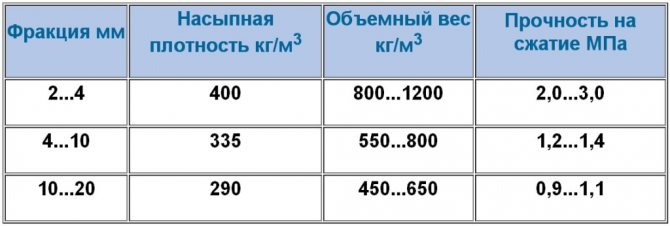

Table of physical properties of expanded clay
Ordinary red clay has the ability to swell when exposed to high temperatures. What, in this case, is harmful to expanded clay, which is a related material to brick? So you can safely use expanded clay for insulation and other construction activities.
Another question if you have to think about what is better to choose as a heater: expanded clay, polystyrene or other material. The fact is that any insulation must be protected from moisture.However, if it suddenly happens that moisture gets into expanded clay, then if a ventilated layer is present, the granules will perform the functions of a kind of drainage, after which the water will evaporate. Polyfoam tends to rot in a wet environment. The material can turn black, and mold can form on it in literally 1 year. In addition, if a fire suddenly occurs, the expanded clay will not support combustion, and the foam will emit harmful and corrosive substances.
Polyfoam is well known for its moisture-resistant and heat-insulating characteristics, in addition, it has a fairly high value of the coefficient of elasticity.
The main purpose of the foam is thermal insulation. On the one hand, properly designed foam will retain heat and keep out the cold. On the other hand, it will not allow cooled air masses to penetrate into the room.
The technology of insulation with foam and expanded clay requires certain tools. You will need:
- Perforator or drill;
- Buckets;
- Spatulas;
- Boer;
- Building level;
- Corolla;
- Styrofoam grater;
- Saw for Styrofoam;
- Knife;
- Plaster grater;
- Goats;
- Gloves;
- The woods.
Expanded clay - an inexpensive alternative to foam products


Table of the advantages of expanded clay.
Instead of foam, it is quite possible to use expanded clay. The following tips will help you make insulation more durable and reliable. Expanded clay is often used for floor insulation, and floors, as you know, are constantly exposed to significant loads. In view of this, it is necessary to correctly calculate the size of the expanded clay layer and screed.
Expanded clay must be covered on top of a vapor barrier and waterproofing layer. It is necessary that the canvas overlap the wall structures. Height - not less than the thickness of the expanded clay layer.
Expanded clay insulators come in different fractions. It usually ranges from 5 to 20 mm. To ensure greater reliability, you can use expanded clay of 2 fractions at once. Backfilling is done according to a method known as wedging. To get a flat surface, you need to bring the level and place the beacons in accordance with the markings made. The first beacon is installed at a short distance from the wall surfaces. All other elements are parallel. The step is determined by the screed.
Warming with expanded clay is a process as effective as it is simple: it can be done independently, even without special skills.


Foam Advantages Table.
As soon as the beacons are installed in their places, you need to align the position with the building level. The latter is calculated according to a pre-made mark. Next, it is checked how the lighthouses stand in a common plane, after which the mixture is poured over the lighthouses. When it gains sufficient hardness, you can pour expanded clay. The optimum layer thickness is 10 cm. At a lower value, effective heat retention cannot be guaranteed.
There should not be any slope in the backfill. The surface must be strictly flat. The check is carried out using a control measurement. The distance between the previously installed beacon and the backfill itself is determined. For this, an ordinary tape measure or a special template is used.
Before pouring the solution, expanded clay must be treated with cement milk. It will promote the setting of the insulation layer, due to which there will be no movement in the process of feeding the mixture. In order for the screed to function as a whole, mesh reinforcement must be performed. The resulting surfaces will not be afraid of deformation forces. You can use the floor (walk) after 5-8 days. This is how much time, on average, the cement slurry is gaining hardness. Strength gain lasts 3-4 weeks. By the way, you can check the strength of the surface in an elementary way. You need to take a regular jar and set it upside down.If the inside of the jar becomes covered with condensation, the floor is still damp and cannot be walked on.
You can check without a can by resorting to a simple visual inspection. Areas with high humidity are usually visible even to the naked eye. After covering the top layer of the screed with this or that material, we can assume that you have succeeded in insulating the floor of the house for a long period. Are there alternatives to expanded clay? If you think that expanded clay will be too heavy for bulk thermal insulation, you can use other expanded and porous backfills. For example, agloporite, similar in characteristics to expanded clay, is quite suitable - something like pumice with a structure resembling glass. This filler is made from low-melting clays mixed with a charge of coal mining waste and shale, with ash and slag from TPP furnaces. However, the environmental friendliness of this material is in great doubt. Another good alternative to expanded clay is expanded perlite. It has a lower moisture absorption, but a very good thermal conductivity.
Expanded vermiculite can be considered the best option for replacing expanded clay. This material, belonging to the group of hydromicas and obtained from rocks, is environmentally friendly. If we compare the coefficients of thermal conductivity, then for expanded clay it is 0.1, and for vermiculite - 0.08, which is 2 times less than that of mineral wool. The bulk density of 1 m³ of expanded vermiculite is 100 kg - a relatively small value. In the case of using this material, the backfill layer will be thinner, the load on the floor is lower, and the base for the screed is quite acceptable.
Floor insulation with foam plastic under the screed
Polyfoam is considered one of the most common insulation materials, the material is widely used to insulate not only the floor, but also walls and foundations.
Benefits:
- ease of installation;
- low consumption;
- no need for vapor barrier;
- long service life;
- resistance to microorganisms.
Disadvantages:
- ease of ignition;
- significant harm from rodents.
Technology
The insulation process consists of several stages.
All cracks and dents are removed on a surface cleaned of dust and dirt; for this purpose, construction foam, putty or concrete are used. A prerequisite is that the floor must be perfectly flat, the level of thermal insulation depends on the density of the foam plastic to its surface. If this condition is not observed, so-called "cold bridges" are formed on the floor, which can significantly reduce the effect of insulation.
At the next stage, waterproofing is laid, which is most often used as ordinary polyethylene. To increase the tightness of the flooring, the joining areas are glued with tape, after which the insulation is laid. In this case, foam of a certain brand and density is used, the thickness of which should be 5 cm.
Next, the outer layer is reinforced with a screed 1.5-2 cm thick, on top of which a reinforcing mesh is laid. At the final stage, the construction concrete mixture is poured, the layer should be 5-6 cm.
Floor insulation with polyurethane foam
Polyurethane foam has recently been used more and more often for floor insulation, despite its rather high cost. The costs are fully paid off due to the absence of costs for waterproofing and vapor barrier coating, surface lathing and additional installation work.
Benefits:
- durability (from 50 years);
- speed and ease of installation;
- moisture resistance;
- security;
- lack of "cold bridges".
Disadvantages:
- the need for protection from sunlight;
- the need to use additional equipment and workwear.
Technology
Polyurethane foam is sprayed onto a surface previously cleaned of dust and dirt in an even layer. The method allows you to create an integral layer without cracks and gaps, provides surface insulation of the most complex configuration.
Floor insulation with penofol
Penofol is a multi-layer material of the class of reflective insulation, consists of a base layer and polished foil. Polyethylene foam of different thickness, structure and density is used as a base.
Benefits:
- environmental friendliness;
- no need for additional vapor barrier;
- soundproofing;
- ease of installation;
- fire safety;
- ease of transportation;
- inaccessibility for rodents.
Disadvantages:
- softness;
- complexity of installation;
- use as additional material.
Technology
The material is laid over the entire surface of the floor covering with the metal side up. A 20-millimeter air gap is created in front of it, all joints formed during the laying process are provided with reliable tightness.
Aluminum adhesive tape is excellent for this. On top of the insulation, a material is laid to ensure the hardness of the base. Hardboard is considered the best option in this case; any floor covering can be used as a finish.
Thermal insulation of the floor with ecowool
Ecowool is made from natural materials, 20% it consists of waste paper, 20% - from natural additives. Cellulose fibers are used as a base, boric acid and lingin are the binder.
Benefits:
- environmental friendliness;
- low thermal conductivity;
- fire safety;
- restoration of thermal insulation properties after drying.
Disadvantages:
- high price.


